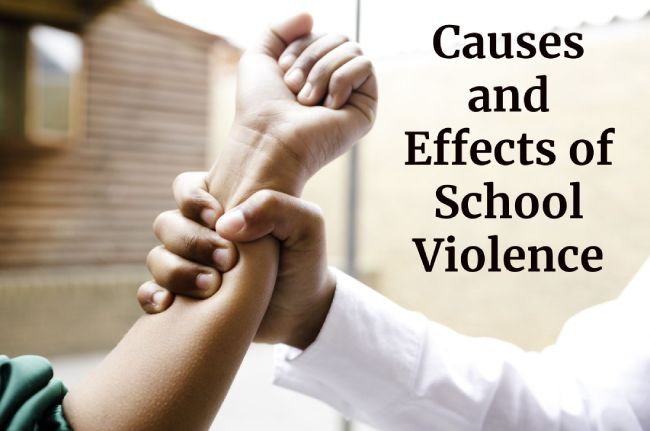The problem of school violence is more complex than it appears at first glance. It is not a case that any single factor causes school violence on its own, nor is there a single effect that comes as a result of violence.
Potential Causes of School Violence
Almost all of us have seen school violence during the last few years on television news broadcasts; large tragedies, such as the recent Stoneman Douglas shooting, are quite difficult to forget.
However, there are other forms of school violence that teens may experience at school, such as bullying and seemingly insignificant behaviors that contribute to them feeling unsafe at school.
There is no doubt that school violence is a very dangerous issue because it can be difficult to pinpoint exactly what causes it to occur.
Media and Entertainment
In order to explain this phenomenon, many have blamed violent video games that children play, music that includes suggestive and sensitive lyrics, and movies that cause children to become desensitized to violence.
There is little evidence to suggest that these types of entertainment have long-term effects leading to an increase in school violence, however. There are some who argue that the content of media is not the direct cause of this problem, but that the lack of adult supervision and conversation about violent media could also play a role.

Bullying
In a world where there is such a wide variety of people, such as a wide range of races, sexual orientations, belief systems, and nationalities, it can be difficult to feel like you fit in with everything that is going on. It can be hard to find your place if everyone around you makes fun of you for the qualities that make you different from them, which can make it difficult for you to fit in.
The intolerance, discrimination, and bullying that many people in our society face may be contributing factors to school violence. While fewer than one out of ten bullied students go on a shooting spree, about half of school shooters show evidence of having been bullied and about half of them have been bullied themselves.
Some critics of this argument point out that every teenager faces a certain level of intolerance at some point in their lives, and that teens who break must be going through something different than others.
Access to Weapons
There are many different ways in which today’s teens are exposed to weapons, particularly guns, in a much different manner than previous generations. While the U.S. does not have a higher overall crime rate than other developed countries, the U.S. suffers from significantly higher gun violence and has a higher number of civilian gun owners when compared to other developed countries.
The majority of the population believes that the government should have control over gun ownership, but only about half of it agrees. Kids are witnessing and hearing a great deal about the debate about gun rights and legislation in the media and in politics on a daily basis.
Mental Health Concerns
Roughly half of all adolescents in the U.S. have some type of mental disorder. Of these kids, about half suffer from severe mental health impairment. Psychological disorders and mental health concerns, such as depression and anxiety, have been on the rise for decades.
While these complex issues can contribute to violent behavior, they aren’t a given in school violence perpetrators. The FBI’s School Shooter Threat Assessment suggests a profile of a school shooter doesn’t exist because each scenario features a unique set of circumstances.
Effects of School Violence
A little more than 1 out of seven of all school-age children have been the victims of a physical assault at school. Some of the most damaging effects of school violence are the frequency of occurrence, which can cause fear and the loss of innocent lives.
However, the impact of school violence is even less understood than the causes because research on this topic tends to focus on perpetrators and prevention.
Detracts From Education
Teachers are not only victims of school violence on some occasions, but they are tasked with being on the lookout for troubled students and taking great measures to connect on a personal level with students.
This heightened attention to school safety is unfortunately necessary, but it indicates a shifting perspective in American viewpoints of school.
Decreases Academic Performance
Research shows exposure to an incidence of violence contributes to lower test scores, but it doesn’t necessarily impact grades because homework isn’t affected. Part of this can be explained by the finding sleep disruption from the incident could be the culprit.
Kids who are distracted and getting poor sleep aren’t able to concentrate on major educational tasks like testing.
Creates Mental Health Concerns
After an incidence of violence, many students end up feeling fearful of other students or of going to school. These fears can lead to more serious conditions like depression, Post-Traumatic Stress Disorder (PTSD), and the ability to form secure attachments.
Some of these issues may not present for days, weeks, or even years after exposure to a traumatic event.
Prevention Is Key
No one will ever know the exact reason as to what causes more extreme cases of school violence. However, no matter the expert, one thing everyone can agree on is that violence in schools needs to stop.
Rather than focusing on what is behind violence in schools or what can happen as a result of it, everyone needs to become focused on preventing school violence.
